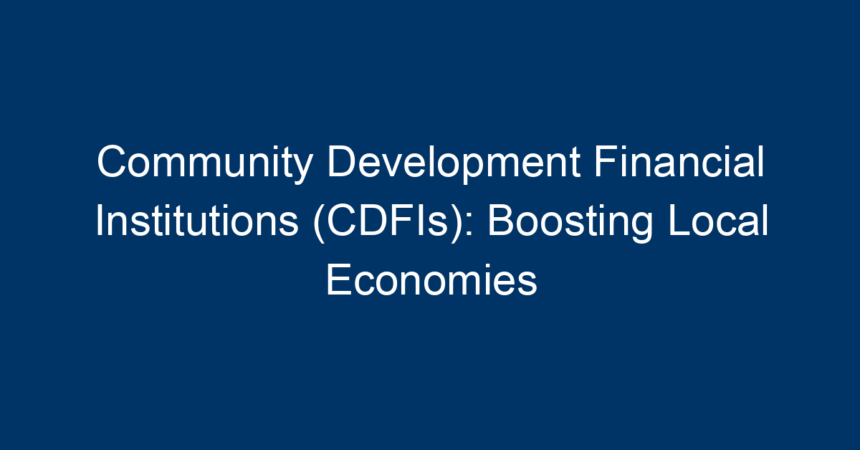In the ever-evolving landscape of economic development, Community Development Financial Institutions (CDFIs) have emerged as powerful catalysts for local economies. These specialized financial institutions are dedicated to fostering economic growth and revitalization in underserved communities. By addressing the funding gaps that traditional banks often overlook, CDFIs play a pivotal role in enhancing community resilience and providing sustainable growth opportunities.
What Are Community Development Financial Institutions (CDFIs)?
CDFIs are private financial institutions that provide credit, capital, and financial services to underserved markets and populations. Established under the U.S. Department of the Treasury’s CDFI Fund, these institutions aim to foster economic revitalization and opportunity among low-income individuals and communities. Unlike traditional banks, CDFIs focus on creating positive social impacts alongside financial returns.
Types of CDFIs
- Community Development Banks: These banks provide tailored banking products to underserved communities, often reinvesting profits into community enhancement projects.
- Community Development Credit Unions: These member-owned institutions focus heavily on providing access to credit and savings options for low-income members.
- Community Development Loan Funds: These funds offer loans for projects that stimulate economic development in low-income areas, such as affordable housing initiatives and small business development.
- Community Development Venture Capital Funds: These funds invest equity in businesses that may lack access to traditional venture capital.
The Importance of CDFIs in Local Economies
1. Bridging the Capital Gap
Community Development Financial Institutions are essential in bridging the capital gap for businesses and individuals who face discrimination in the lending process. Traditional banks often have stringent requirements that many low-income individuals and businesses don’t meet. CDFIs mitigate this issue by providing more flexible lending criteria, thus enabling greater access to financial resources.
2. Creating Jobs
Job creation is another significant benefit of CDFIs. By financing small businesses and entrepreneurs in underserved communities, these institutions directly contribute to local employment opportunities. Many CDFIs provide not only capital but also business support services, such as financial literacy training and mentoring.
3. Supporting Affordable Housing
Housing instability is a critical issue affecting countless families. CDFIs are instrumental in financing affordable housing projects, thus addressing this pressing need. By providing loans to developers who focus on creating affordable housing units, CDFIs help ensure that families have access to safe and reasonably priced homes.
4. Stimulating Local Economies
Investing in local businesses through CDFIs fosters economic revitalization. The money spent at local businesses tends to circulate within the community, creating a multiplier effect that benefits various sectors. As local businesses thrive, they contribute to the overall economic health of the community.
How CDFIs Function
Funding and Resources
The primary funding sources for Community Development Financial Institutions include government grants, loans, and private capital. For example, the CDFI Fund provides monetary support to CDFIs through allocations and awards, which helps them extend their reach in providing financial services.
Risk Management
CDFIs often operate with a unique risk assessment model. Given their focus on impact over profit, their risk tolerance is typically higher than that of traditional financial institutions. This willingness to take calculated risks enables them to support ventures that may be deemed too risky for conventional lenders.
Success Stories: CDFIs in Action
1. Capital Impact Partners
Capital Impact Partners is a notable CDFI that has transformed communities through investments in healthcare, housing, and education. The organization provides capital to entities that benefit low-income residents, leading to improved health outcomes and increased access to quality housing.
2. Opportunity Fund
Opportunity Fund focuses on providing loans to small business owners in underserved communities. With a commitment to supporting Latino and low-income entrepreneurs, they provide not just capital but also valuable business resources, leading to increased business success rates and job creation.
Challenges Facing CDFIs
1. Limited Awareness
Despite their significant impact, many communities remain unaware of the resources that CDFIs offer. This lack of awareness can hinder potential borrowers from accessing the financial support they need.
2. Funding Constraints
While CDFIs are crucial for economic development, they often operate with limited funds, making it challenging to expand their reach. Ongoing support from the government and private investors is essential for CDFIs to continue their vital work.
3. Integration into the Broader Financial System
CDFIs face challenges in integrating into the broader financial system, often finding themselves isolated from traditional banking networks. By fostering relationships with major financial institutions, CDFIs can facilitate access to additional funding sources.
The Future of CDFIs
The future of Community Development Financial Institutions is promising but requires commitment and collaboration. Increasingly, CDFIs are reaching out to innovative funding sources such as impact investors and social enterprises. Moreover, as awareness of social responsibility continues to grow, more traditional banks may partner with CDFIs to expand their outreach to underserved communities.
Actionable Insights for Individuals and Communities
-
Educate Yourself: Learn about the local CDFIs available in your area. Many resources online can guide you toward finding these institutions and understanding their offerings.
-
Leverage CDFIs for Financing: If you’re an entrepreneur or a small business owner, consider approaching a CDFI for funding to support your venture.
-
Support Local CDFIs: If you’re in a position to invest, consider directing your funds toward CDFIs that focus on community development. Your investment can lead to meaningful changes in local economies.
- Advocate for CDFI Funding: Encourage your local and state government representatives to continue funding CDFIs. Highlight their role in driving economic development and supporting low-income communities.
Conclusion
Community Development Financial Institutions (CDFIs) are at the forefront of fostering economic growth and community resilience. By addressing funding gaps, creating jobs, supporting affordable housing, and stimulating local economies, CDFIs serve as powerful tools for positive change. As communities continue to face economic challenges, CDFIs will play an increasingly vital role in revitalizing neighborhoods and providing opportunities for all. For individuals and policymakers alike, understanding and supporting CDFIs is essential for building a more equitable and prosperous future.




